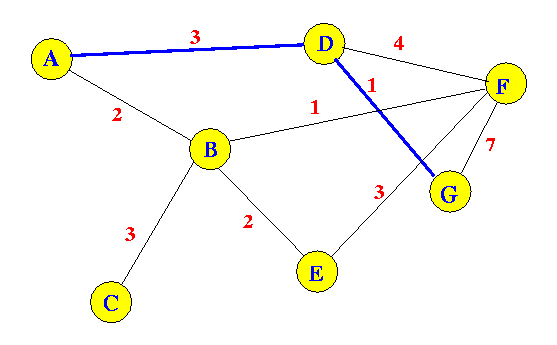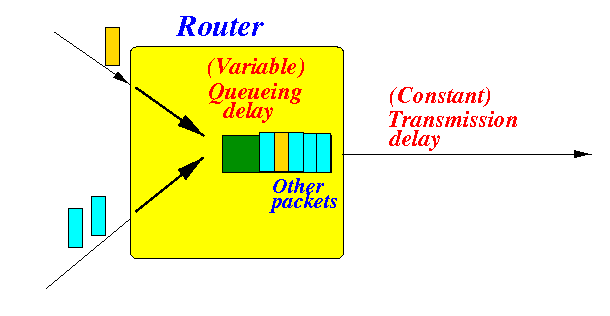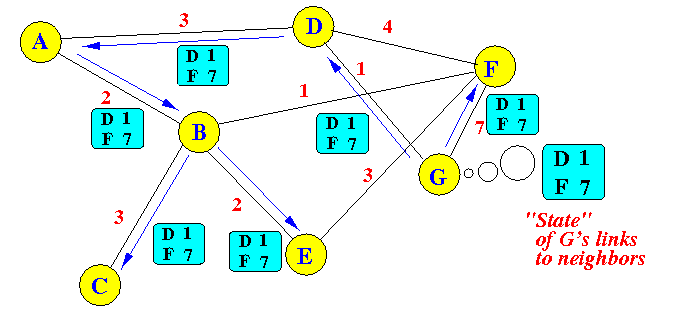- A network can be represented by a graph.
- A graph
consists of a
set of nodes
and a
set of edges
connecting
the nodes.
- Each edge on the graph has a
cost
associated with it.
The cost represent the delay/time it takes for a packet to traverse the network link.
- Example network:

- A route
from a
source node
to a
destination node
is a
path
in the graph
A path is a serie of NON-CYCLIC (no cycles or loops) adjacent edges in the graph.
- Example: the following is a path from node
A to G:

- There may be
many paths
between 2 nodes
- The cost of a path
is the
sum of the cost of the edges
of the path.
- The mininum cost path
is the path that has the
lowest total cost
between source and destination
- Example: the following is a minimum path from node
A to G:

- The following diagram shows all the
minimum cost paths
from node B
to all other nodes in the network:

- For node B:
- To send packets to A use: B -> A with cost 2
- To send packets to C use: B -> C with cost 3
- To send packets to D use: B -> A (-> D) with cost 5
- To send packets to E use: B -> E with cost 2
- To send packets to F use: B -> F with cost 1
- To send packets to G use: B -> A (-> D -> G) with cost 6
- We can summarize the finding for node B
in the following table form:
Destination | Send the of packet | packet to --------------+------------ A | A B | - C | C D | A E | E F | F G | AEach entry in the table has the following format:
-
(Destination, Next Hop)
- Each node
in the network has its own
routing table
- The following diagram shows the routing tables of
a few nodes

A few entries in the routing tables of nodes A and D are highlighted in red to indicate that these entries in nodes A and D are used to forward packets from B that are destined for nodes D and G
The diagram illustrates that the information about how to route a packet are maintained in a distributed manner :
- Each node individually
only know the
next hop
towards
any (final) destination
- All nodes collectively know the PATH from any source node to any destination node
- Each node individually
only know the
next hop
towards
any (final) destination
- The $64,000 question:
-
How are the entries in the routing table computed ???
- The
Internet routing algorithm
always try to construct the
minimum cost (delay) paths
between two hosts.
- A packet that enters a router for processing will
experience
2 delay components:
- Queueing delay:
the packet must
wait
(in the buffer of the output link)
for its turn to be transmitted.
Queueing delay is highly variable and can be very high - it's analogous to traffic jam delay.
- Transmission delay:
this is the time it takes to actually transmit the packet.
Transmission delay takes a (fixed) amount of time and it is only dependent on:
- packet length and
- transmission speed of link.

- Queueing delay:
the packet must
wait
(in the buffer of the output link)
for its turn to be transmitted.
- One of the most important problem that need to be solved in
the implementation of the Internet is the computation of the
routing tables.
- Facts:
-
A node (router)
in the Internet is only
aware of its
immediate neighbor nodes
- A node (router)
can measure the
delay to these neighbor nodes
(through delay in receiving the ACK message)
- Without performing a search operation, a node does not have any information on other nodes outside their immediate neighbor nodes.
-
A node (router)
in the Internet is only
aware of its
immediate neighbor nodes
- Therefore:
Nodes in the network must exchange information with each other to allow them to get the complete information on the link costs in the network and how the nodes are connected together.
- There are
2 approaches
in constructing the routing table
- A node sends the
current state of its links
(to its immediate neighbors) to
ALL NODES in the network:

Result:
-
If every node
send its link state information to
every other node , then
(after all the messages have been received)
every node
will have information
on the whole network.
- Information on graphs can be represented by a
connectivity matrix
- For example, the above network can be represented by the
following matrix:
A B C D E F G +- -+ A | - 2 - 3 - - - | B | 2 - 3 - 2 1 - | C | - 3 - - - - - | D | 3 - - - - 4 1 | E | - 2 - - - 3 - | F | - 1 - 4 3 - 7 | G | - - - 1 - 7 - | +- -+ - Because each node have
information of the whole network,
each node can compute the
short path on their own -
without further help
from one another.
-
The resulting algorithm is a
centralized algorithm.
- In fact, the algorithm has a famous name: the Dijkstra's Algorithm for finding minimum distance paths.
-
If every node
send its link state information to
every other node , then
(after all the messages have been received)
every node
will have information
on the whole network.
- A node sends
ALL information that it has gathered
to
only its immediate neighbors.
This method is analogous to gossiping !!!
- First a node A tells its neighbors what it knows (which is not much at the start)
- A neighbor node will tell its neighbors the information of what it knows and the information that it received from A
- And so on... the amount of information keeps increasing...
The following figure depicts the information exchange:

When node D receives the information from D, it can deduce further information
Example:
- D knows its distance to A is 3
- From A's message, D knows A's distance to the node B is 2
- D can deduce that the distance between itself (D) and B is 3 + 2 = 5 via node A

When a node sends everything that it knows to its immediate neighbors, the resulting algorithm is a distributed algorithm.
This distributed path computation algorithm is called the distributed Bellman-Ford algorithm.
The resulting routing algorithm based on distributed Bellman-Ford is called Distance Vector protocols (because nodes exchange "distance vectors" with each other).
- A node sends the
current state of its links
(to its immediate neighbors) to
ALL NODES in the network:
We will only look at the Dijkstra's algorithm. (Because this is undergraduate material and routing is presented here only to help you understand multicast routing )